How to drive a DC motor fan with Arduino?
This guide covers how to control a DC motor fan (like a cooling fan) using an Arduino, including speed control with PWM, direction control with an H-bridge, and protection circuits.
1. Components Needed
| Component | Purpose |
|---|---|
| Arduino (Uno/Nano) | Motor control logic |
| DC Motor Fan (5V/12V) | Example: 12V PC fan |
| Transistor (TIP120, 2N2222) | For small motors (≤500mA) |
| MOSFET (IRF540N, IRLB8721) | For high-current motors (≥1A) |
| Diode (1N4007) | Flyback protection |
| Resistor (220Ω-1kΩ) | Limits base/gate current |
| Power Supply | Must match motor voltage (e.g., 9V battery, 12V adapter) |
2. Basic On/Off Control (No Speed Control)
Circuit Diagram
Arduino 5V → Motor (+) Arduino GND → Motor (-)
⚠️ Warning: Only works for very small motors (≤100mA). For larger motors, use a transistor/MOSFET.
3. Using a Transistor (TIP120) for Medium Loads
Wiring (NPN Transistor)
Arduino Pin 9 → Resistor (1kΩ) → TIP120 Base TIP120 Collector → Motor (+) TIP120 Emitter → GND Motor (-) → Power Supply (+) Power Supply (-) → GND Place 1N4007 diode across motor (reverse-biased).
Arduino Code (On/Off)
void setup() { pinMode(9, OUTPUT); } void loop() { digitalWrite(9, HIGH); // Motor ON delay(2000); digitalWrite(9, LOW); // Motor OFF delay(2000); }
4. Speed Control with PWM (Pulse Width Modulation)
Wiring (Same as Above, but PWM Pin)
Use Pin 3, 5, 6, 9, 10, or 11 (PWM-capable pins on Arduino Uno).
Arduino Code (Variable Speed)
void setup() { pinMode(9, OUTPUT); } void loop() { // Ramp up speed (0-255) for (int speed = 0; speed <= 255; speed++) { analogWrite(9, speed); delay(20); } // Ramp down speed for (int speed = 255; speed >= 0; speed--) { analogWrite(9, speed); delay(20); } }
5. Using a MOSFET (IRF540N) for High-Current Motors
Wiring (N-Channel MOSFET)
Arduino Pin 9 → Resistor (220Ω) → IRF540N Gate IRF540N Drain → Motor (+) IRF540N Source → GND Motor (-) → Power Supply (+) Power Supply (-) → GND Add 1N4007 diode across motor.
Arduino Code (Same as PWM Example)
MOSFETs handle higher currents (up to 20A with heatsink).
6. Direction Control (H-Bridge: L298N)
If your fan can reverse direction (uncommon for PC fans), use an H-bridge like the L298N.
Wiring (L298N)
Arduino IN1 → Pin 8 Arduino IN2 → Pin 9 L298N OUT1 → Motor (+) L298N OUT2 → Motor (-) Power Supply → L298N 12V Input GND → Common ground
Arduino Code (Forward/Stop/Reverse)
void setup() { pinMode(8, OUTPUT); pinMode(9, OUTPUT); } void loop() { // Forward digitalWrite(8, HIGH); digitalWrite(9, LOW); delay(2000); // Stop digitalWrite(8, LOW); digitalWrite(9, LOW); delay(1000); // Reverse (if motor supports it) digitalWrite(8, LOW); digitalWrite(9, HIGH); delay(2000); }
7. Adding Temperature-Based Fan Control
Circuit Additions
Temperature Sensor (DS18B20/DHT11) → Arduino analog pin.
PWM Fan Control → Adjust speed based on temperature.
Arduino Code (Auto Speed Control)
#include <OneWire.h> #include <DallasTemperature.h> #define ONE_WIRE_BUS 2 // DS18B20 on Pin 2 OneWire oneWire(ONE_WIRE_BUS); DallasTemperature sensors(&oneWire); int fanPin = 9; void setup() { pinMode(fanPin, OUTPUT); sensors.begin(); } void loop() { sensors.requestTemperatures(); float tempC = sensors.getTempCByIndex(0); // Map temperature (e.g., 25°C-50°C → 0-255 PWM) int fanSpeed = map(tempC, 25, 50, 0, 255); fanSpeed = constrain(fanSpeed, 0, 255); analogWrite(fanPin, fanSpeed); delay(1000); }
8. Safety & Protection
Flyback Diode (1N4007) – Prevents voltage spikes from damaging Arduino.
Separate Power Supply – Don’t power motors from Arduino’s 5V pin.
Fuse (Optional) – Add a 1A fuse for overcurrent protection.
9. Common Issues & Fixes
| Problem | Solution |
|---|---|
| Motor doesn’t spin | Check transistor/MOSFET wiring |
| Motor runs at full speed only | Verify PWM code & pin |
| Arduino resets when motor starts | Use a separate power supply |
| MOSFET gets hot | Add a heatsink or reduce load |
Conclusion
Small motors (≤500mA): Use a transistor (TIP120).
Larger motors (≥1A): Use a MOSFET (IRF540N).
Speed control: Use PWM (
analogWrite()).Direction control (rare for fans): Use an H-bridge (L298N).
Automation: Add a temperature sensor for smart cooling.




评论
发表评论